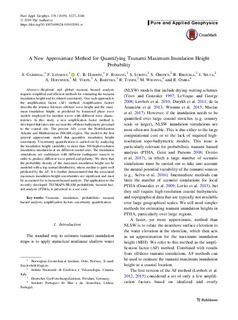A New Approximate Method for Quantifying Tsunami Maximum Inundation Height Probability
Glimsdal, Sylfest; Løvholt, Finn; Harbitz, Carl Bonnevie; Romano, F.; Lorito, S.; Orefice, S.; Brizuela, B.; Selva, J.; Hoechner, A.; Volpe, M.; Babeyko, A.; Tonini, R.; Wronna, M.; Omira, R.
Peer reviewed, Journal article
Permanent lenke
http://hdl.handle.net/11250/2605148Utgivelsesdato
2019Metadata
Vis full innførselSamlinger
- NGI articles [1061]
Sammendrag
Regional and global tsunami hazard analysis requires simplified and efficient methods for estimating the tsunami inundation height and its related uncertainty. One such approach is the amplification factor (AF) method. Amplification factors describe the relation between offshore wave height and the maximum inundation height, as predicted by linearized plane wave models employed for incident waves with different wave characteristics. In this study, a new amplification factor method is developed that takes into account the offshore bathymetry proximal to the coastal site. The present AFs cover the North-Eastern Atlantic and Mediterranean (NEAM) region. The model is the first general approximate model that quantifies inundation height uncertainty. Uncertainty quantification is carried out by analyzing the inundation height variability in more than 500 high-resolution inundation simulations at six different coastal sites. The inundation simulations are undertaken with different earthquake sources in order to produce different wave period and polarity. We show that the probability density of the maximum inundation height can be modeled with a log-normal distribution, whose median is quite well predicted by the AF. It is further demonstrated that the associated maximum inundation height uncertainties are significant and must be accounted for in tsunami hazard analysis. The application to the recently developed TSUMAPS-NEAM probabilistic tsunami hazard analysis (PTHA) is presented as a use case.
